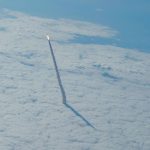Key Takeaways:
- NASA’s Operation IceBridge has captured images of a perfectly rectangular iceberg in Antarctica.
- The iceberg was spotted during a flight over the northern Antarctic Peninsula as part of ongoing polar ice documentation efforts.
- This uniquely shaped iceberg features right-angle corners, a rare phenomenon according to senior support scientist Jeremy Harbeck.
- The iceberg was noticed off the Larsen C ice shelf, standing out amidst other ice formations.
- While the focus was on a nearby larger iceberg, Harbeck found this rectangular iceberg visually captivating and took photos.
NASA’s relentless quest to understand and monitor Earth’s changing environment has unveiled a captivating discovery – a perfectly rectangular iceberg floating near the Larsen C ice shelf in Antarctica. This remarkable find comes as a result of NASA’s Operation IceBridge, an ongoing mission aimed at tracking shifts in polar ice formations. The images, taken during a research flight over the northern Antarctic Peninsula, reveal a striking iceberg with crisp right-angle corners, a sight rarely seen before.
Jeremy Harbeck, a senior support scientist involved in the mission, expressed his fascination with the iceberg’s unusual geometry. While the team’s primary focus was directed towards a massive iceberg of Delaware proportions nearby, Harbeck couldn’t resist capturing the visually enthralling rectangular iceberg. His images not only showcase the pristine rectangular form but also underscore the intricacies of Earth’s polar icescape. This discovery sheds light on the dynamic and diverse nature of icebergs, constantly sculpted by the forces of nature.
Read full article on Business Insider
#1

A Landsat 8 satellite image shows part of the northern Antarctic Peninsula, with an arrow pointing to the rectangular iceberg. NASA/Christopher Shuman
#2

NASA scientists found a number of large icebergs between Antarctica’s Larsen C ice shelf and the A-68 ice island, which separated from the ice shelf last year. NASA/Jefferson Beck
#3

The A-68 ice island is roughly the size of Delaware.
#4

NASA’s flying research laboratory carried the scientists around Antarctica. The aircraft is a modified Douglas DC-8 jetliner. NASA/Jefferson Beck
#5

Just past the now-famous iceberg, NASA also captured another iceberg that was relatively rectangular. NASA/Jeremy Harbeck
#6

The panorama below shows the whole iceberg. It was edited together from two images taken from the DC-8 laboratory. NASA/Jeremy Harbeck
#7

A tabular iceberg floats near the coast of West Antarctica as seen from a window of a NASA Operation IceBridge airplane (Mario Tama/Getty Images)
#8

A sheer wall of the iceberg B-46 looms over a mix of sea ice, bergy bits, and snow at the base of Pine Island Glacier, as seen from a NASA Operation IceBridge flight on Nov. 7, 2018. Credits: NASA/Kate Ramsayer
#9

The rift between Pine Island Glacier and a new giant iceberg, dubbed B-46, in Antarctica. Credits: NASA/Kate Ramsayer
#10

The NASA DC-8 aircraft’s shadow is dwarfed in scale by the B-46 iceberg. Credits: NASA/Brooke Medley
#11

In massive ice streams that appear solid and unmoving, it’s the crevasses that remind you the ice is in motion, said Thorsten Markus, ICESat-2 project scientist. These giant breaks form as the faster ice downstream pulls away from the slower ice upstream. Credits: NASA/Brooke Medley


